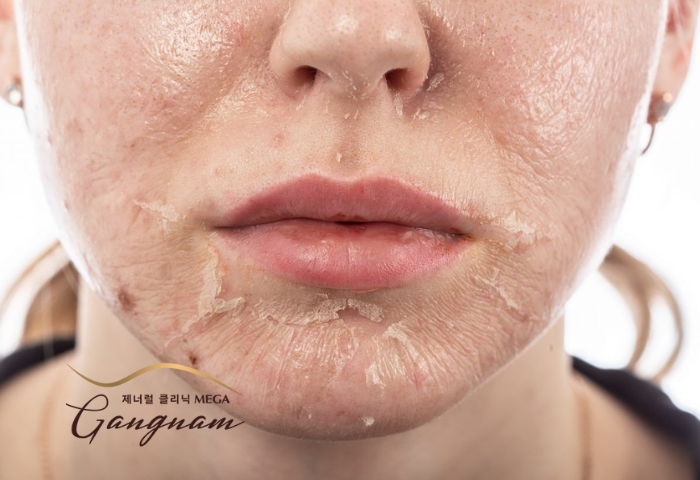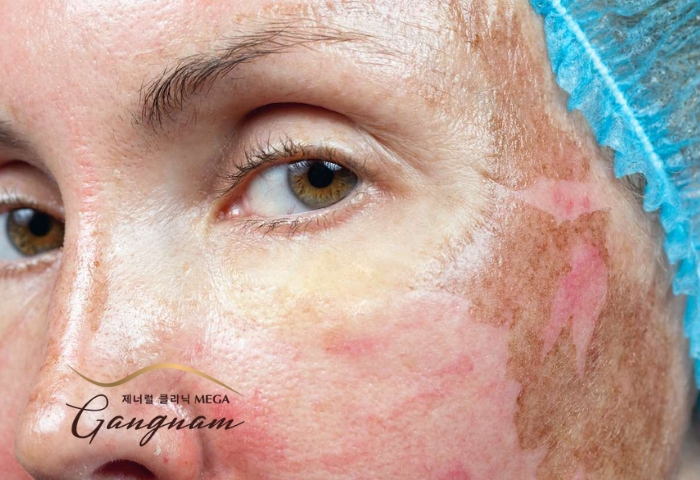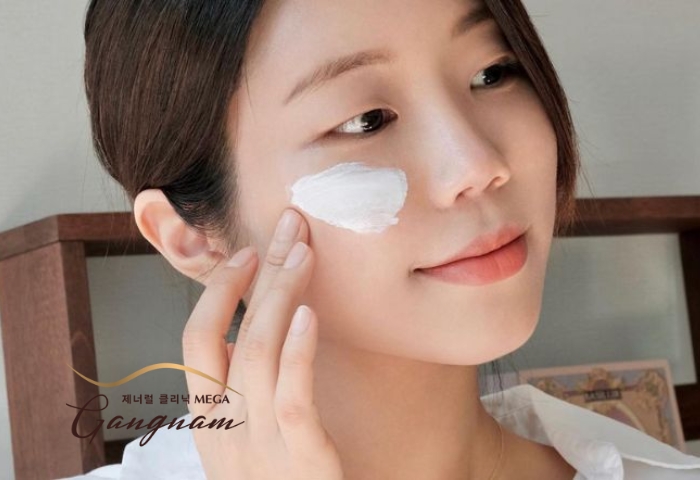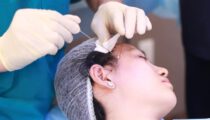Skin hyperpigmentation after peel: Causes, symptoms and treatment
The mechanism of skin shedding to maturity exists in many organisms and it is not surprising. So what about humans? Maybe you don’t know! Cells on the skin’s surface will die after a certain period of time. Therefore, re-establishing these cells is essential for all activities to occur normally.
Skin peeling is a special method capable of promoting skin turnover quickly. It not only helps remove dead cells and dark spots, but also creates a premise for new healthy cells to develop. However, there is a phenomenon that people often mention: skin hyperpigmentation after peeling. Let’s learn information about this condition to have the best prevention method!

Facial hyperpigmentation after peel
What is hyperpigmentation?
Hyperpigmentation is a common and harmless phenomenon for the human body. The condition of skin becoming darker and darker than normal due to a certain cause is a specific manifestation of this syndrome. Depending on different factors, the speed and ability to develop dark pigmentation patches are not uniform. In cases where the patient has weak resistance and the cause is too complicated, pigmented lesions develop quickly and easily cover the entire body.

Các biểu hiện tăng sắc tố da sau peel
According to experts, the direct cause of increased skin pigmentation is due to excessive activity of melanin. The faster the synthesis process occurs and the higher the level, the more obvious the signs of hyperpigmentation. Some signs that show skin hyperpigmentation are as follows:
Melasma: Considered one of the syndromes related to the abnormal increase of pigment on the surface. Melasma occurs in many areas of the body but focuses mainly on the face and is more common in women. There are three main types of melasma: spotty melasma, patchy melasma and a mixture of the above two groups. Abnormal changes in hormones, sunlight, cosmetics or medications are the biggest causes of melasma. The sad thing is that melasma is very difficult to treat thoroughly and takes a lot of time.
Freckles: Also classified as common manifestations of hyperpigmentation, freckles appear in many subjects. People often confuse freckles with melasma, however freckles are more colorful and lighter than melasma. At the same time, the ability to treat these signs of damage is also better because the foot is only located on the upper layer, which is the skin epidermis.
In fact, freckles are mainly formed due to the two biggest causes: genetics and sunlight. If many people in the family have freckles at a very young age, there is a high possibility that this manifestation is related to genetic biological characteristics. Meanwhile, sunlight with its strong UV rays easily penetrates and causes serious effects on the body. Therefore, the anti-melanin synthesis mechanism happens faster to protect the skin and fight harmful agents. Some other diseases that increase the risk of hyperpigmentation disorders are:
Age spots: Usually appearing in people from middle age onwards, age spots are characterized by pigment spots ranging from yellow brown to black brown. The main cause of age spots is sunlight. This condition becomes more dangerous if there are no measures to cover and protect the skin. A lot of evidence has shown that age spots develop into cancer over time.
Patches of skin that are darkened and red after inflammation are also classified as hyperpigmentation. There are many causes leading to this phenomenon such as: burns, trauma, poisoning, increased pigmentation after injections, microneedling or skin peeling… These dark spots are better treatable than other forms of blemishes. other hyperpigmentation.
Is skin hyperpigmentation after peel dangerous?

Is hyperpigmentation after skin peeling dangerous?
The skin peeling process uses a number of active ingredients that erode or peel off the outer layer of skin with the purpose of stimulating the growth of new cells. The ingredients used are Salicylic Acid, Glycolic Acid with different concentrations depending on the user’s skin condition and needs. Although skin peeling has been proven to be a safe and practical beauty method. However, under the action of high concentrations of acids, some people may be damaged, their skin becomes red, thinner, weaker and has a stinging, burning sensation. After a while, the red skin areas become dark, this is the phenomenon of post-peel hyperpigmentation that we are learning about.
Skin peeling is suitable for people over 18 years old who are facing aging problems such as: acne, dark spots, oily skin, large pores… In case you have thin, weak skin. Dry, flaky skin, suffering from certain external diseases, and people who are prone to scarring are likely to experience hyperpigmentation. There are also many causes leading to this condition in people with healthy skin. In general, if you do not have clear knowledge about the peel method, you should not do it yourself at home because the worst case scenario is that the skin is too deeply damaged, permanently scarred, and loses its self-regenerative function. Some causes related to peeling techniques and processes leading to hyperpigmentation of the skin are as follows:
- The active ingredients used to peel the skin are too high in concentration or not suitable for the skin’s characteristics.
- The skin base layer at the time of peeling does not meet the requirements, leading to skin irritation, redness, and after a while, dark spots begin to appear.
- Ineffective skin protection steps make it easy for sunlight to attack, causing darkening of the skin, melasma and freckles.
- Using inappropriate skin care and recovery cosmetics after peeling can also lead to dark spots.
- Skin peeling locations do not ensure adequate facilities for treatment, active ingredients used of unknown origin can also cause the skin to degrade faster.
How to prevent skin hyperpigmentation after peeling?
Not everyone will experience hyperpigmentation after a peel. At the same time, we can proactively prevent it early to limit the effects on the skin later. The simplest ways are:

Ways to prevent hyperpigmentation after peel
- Use sunscreen with an appropriate SPF index (30 or higher) and limit sun exposure except in unavoidable circumstances.
- When you first start peeling your skin, you should only choose active ingredients that are gentle, have low concentrations and are suitable for the actual condition of your skin. Careful skin care with specialized products also plays an important role.
- Before and after skin peeling, you need to limit makeup for at least 1 week because the ingredients in many cosmetics can cause acne, allergies, etc.
- Clean your skin twice a day with physiological saline and moisturize with purely natural products that do not contain alcohol, fragrance, color, or smell…
- See a specialist if after about 5-7 days the facial skin condition has not improved and there are still signs of tightness, burning, and redness.
In case the skin shows signs of hyperpigmentation after peeling and we do not know how to control it, there are two main treatment directions. That is using certain medications that contain ingredients to lighten the skin and resolve pigmented areas with abnormal colors. Some active ingredients are highly applicable, used to reduce pigmentation such as: hydroquinone, retinoids, glycolic acid… Although recommended for people with damaged skin after peeling, this is not always the case. Whichever is suitable. At the same time, the effectiveness of using essences and creams applied to the skin is not high and takes a lot of time.
Another solution that many people choose is to apply intensive skin recovery treatments after peeling. This method is non-invasive, does not cause wounds, but only adds important active ingredients to the correct location of damaged skin. This creates positive changes from within and restores the skin more quickly. You can consider collagen microimplantation, stem cell injections… You should not choose treatment with invasive procedures because of the high possibility of causing more serious damage to your facial skin.
Above is our article about the phenomenon of skin hyperpigmentation after peeling. If you have any questions about facial restoration services, please contact Mega Gangnam via Hotline: 093.770.6666 for advice and support!
Related Articles
- Top 10+ best and most effective facial lotions today
- What should I do if my skin has abnormal hyperpigmentation?
- What is skin pigmentation disorder? Can it be completely treated?
- MEGA FIBER ULTRA-MICROFIBER: MUSCLE TIGHTENING – NON-SURGICAL ADJUSTMENT
- What is Skin Rejuvenation? 10+ Safest and Most Effective Facial Skin Rejuvenation Methods












